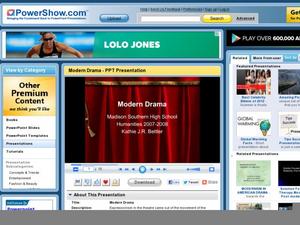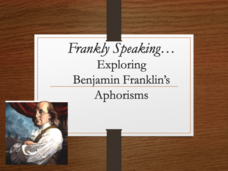Curated OER
Modernism: American Literature 1914-1945
What characterizes modern literature? The first few slides of this 31-slide PowerPoint discuss what sparked the change to Modernism and discuss some of the key figures of the time (like Karl Marx and Sigmund Freud). The 20s and 30s are...
Curated OER
Modern Drama
Upper graders can read all about the origins of modern drama. Each slide provides a paragraph of information related to key players, art movements, and time periods that shaped modern drama. It relates well to many aspects of literature...
Curated OER
Annotated Timeline of The American Literary Movement
How did literature evolve in America? This presentation briefly covers the transition from Puritan American all the way until today's Contemporary Period. Key figures from each time period are introduced, and a brief overview of each...
Chandler Unified School District
Frankly Speaking: Exploring Benjamin Franklin's Aphorisms
Benjamin Franklin famously had an aphorism for every situation—most of which we still use in modern vernacular. Introduce class members to Franklin's Poor Richard's Almanack with a presentation that details the characteristics of aphorisms.
Curated OER
The Evolution of Transcendentalism
Key concepts, major writers, and historical events related to Transcendentalism are explored in a student-produced PowerPoint about this movement. The presentation could be used as an introduction to a unit or as a model that class...
Curated OER
Analogy: Reasoning by Comparison
"Life is like a box of chocolates. . ." "Barack is a Mac, Hillary is a PC." Literal and figurative analogies are featured in a presentation that models how to use analogies to bolster arguments.





